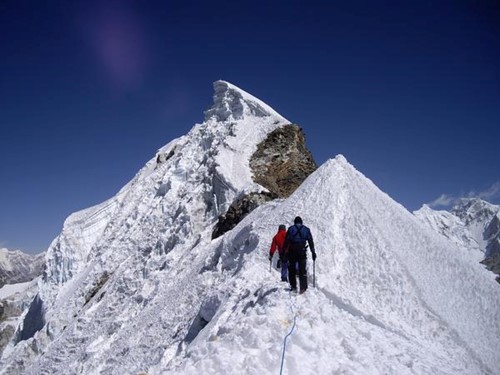Acclimatising safely at altitude and AMS
The physiological factors related to altitude are very complex and still not fully understood. However, in summary, the problem boils down to the fact that your body is placed in an environment where it is initially unable to gain enough oxygen from the air it is breathing.
The good news is that virtually everyone's body will respond and adapt to allow you to acclimatise. This process takes time and can be helped along by adopting certain techniques, these will be explained more fully below but by far the most effective and important ways to manage the effects of altitude are to ascend slowly and to descend if symptoms get out of hand.
As you may expect, when your body is put in this position where it has insufficient oxygen it can make you feel varying levels of physical discomfort which can then progress to dangerous and life-threatening situations if not properly managed.
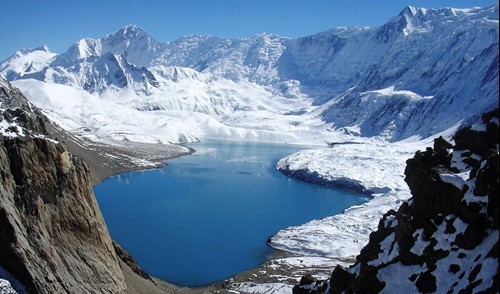
Fantastic views of the Annapurna Circuit.
It is important to note here that your own rate of acclimatisation has nothing to do with fitness and is due to your genetic physiology. Cardiovascular training and being in good physical health will help you to deal with some of the effects of altitude but will not help with your rate of acclimatisation. You may also find that although you have previously acclimatised well you may do less so on a subsequent trip or vice versa.
What to Do
The following measures can be taken to not only promote your health and safety at altitude but also to help you to enjoy yourself rather than enduring a miserable slog. Some of these measures will automatically be built into any Adventure Alternative high altitude itinerary and some will need to be controlled by your own personal management on the trip.
Ascend Gradually
The general guideline that is once above 3000m you should increase your sleeping altitude by no more than 300m each day and to take a rest day every 3 days or so. Due to local geography, this is not always possible so alternative arrangements can work satisfactorily such as progressively higher day hikes from a fixed sleeping altitude before advancing to another.
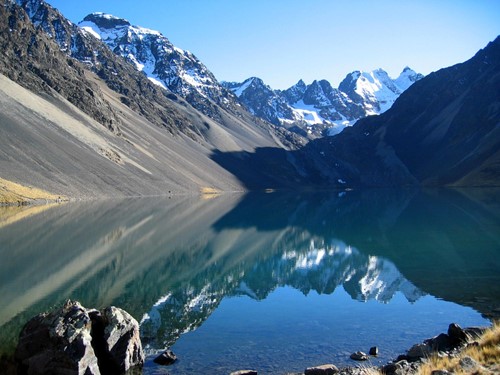
The high peaks of the Andes offer fantastic opportunities for high-altitude trekking and peak bagging.
Climb High, Sleep Low
Each day we try to sleep at a slightly lower altitude to that which we climbed to during the preceding day. That way our bodies are triggered into acclimatising to the peak altitude but we can rest and recuperate better at the slightly lower altitude.
Don't Over Do It
You need to take your time, don't over exert yourself and maintain a sustainable pace. The distances covered each day are rarely large and there is usually plenty of time to complete them. When you get to the next overnight location relax even if you don't feel tired. Try to start every day no more tired than the one before.
Eat Well
The effects of altitude may mean that your appetite decreases. However, it is clearly essential that you are consuming sufficient calories and nutrients to fuel your body. The number of calories you are burning is likely to higher than usual and you should try to eat accordingly. You will almost always feel better after eating even if you did not feel like it beforehand. Some foods are likely to be less appealing than others at altitude. Fatty and dairy products can be less attractive than usual. Take some favourite treats to help you keep fuelled up.
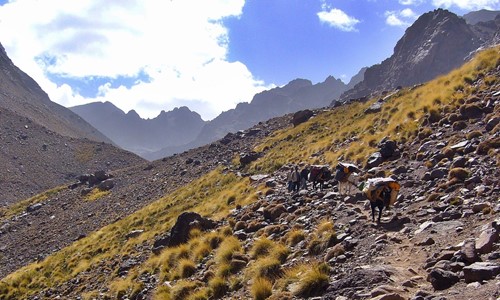
Beautiful ridgelines along the M'Goun Trek.
Drink Well
The dry air, exercise and physiological effects of altitude will mean it is very easy to become dehydrated. This brings its own physical discomforts and potential dangers including a thumping headache. Try to minimise fluid loss in the first place by regulating body temperature and avoiding profuse sweating. Guidance varies but you should aim to be drinking at least 3 litres of fluid a day. This can come in the form of soups and hot drinks as well as water. It can be hard to drink multiple litres of plain cold water every day so flavouring powder can be very useful too. You should also carry some rehydration sachets to use if you do get dehydrated. A good check on your level of hydration is that your urine should be "clear and copious".
Do Not Ascend Further with AMS Symptoms
It is important that you communicate with your trip leader if you have any of the symptoms listed below. Usually, rest at the same altitude will resolve the symptoms and you will be able to ascend. If not we will arrange for you to stay for longer at the same altitude or possibly descend. This does not mean that you will be dumped from the trip and sent home, we will make arrangements so that where-ever possible you can stay with or re-join the group or in any case still get the most possible out of the trip.
Drugs & Pills
There are certain drugs that are promoted as helping with the effects of altitude. The only one that is convincingly shown to aid acclimatisation is Diamox (acetazolamide). It will only really help at altitudes between around 4000 and 5500m and only speeds up the rate of acclimatisation, therefore any worsening effects of AMS must be treated with the same measures as if the patient was not taking it. It will not mask the symptoms of AMS and there is no 'rebound' effect if a course is stopped. We would not recommend the use of Acetazolamide unless there is a specific reason or rationale behind it. This is a prescription medication with a number of physiological effects and you must consult your GP before using it. There are conflicting reports regarding the effectiveness of Aspirin and Ginkgo Biloba as an aid to altitude acclimatisation by their effects on blood composition. The steroid Dexamethasone should only be used at the onset of an altitude related emergency as an aid to the rapid descent. It will only buy a little time for evacuation and should never be used to ascend higher.
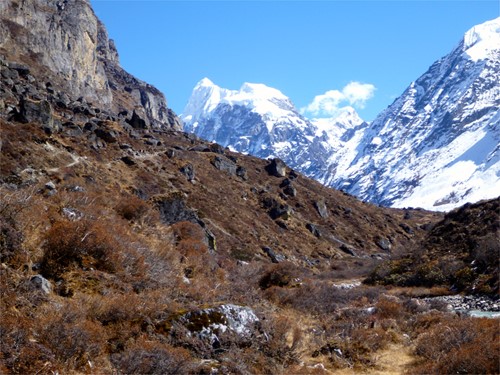
Trekking is a strenuous activity, but you can minimize the risks of altitude by taking care of yourself.
Enjoy Yourself
It should not be underestimated what effect a positive frame of mind can have. You need to be aware of your body's reactions and condition but try not to fall into the trap of "altitude-paranoia". Talk openly with your leaders and teammates about any symptoms, you will find that you are rarely alone.
More Information
As you ascend in altitude the amount, and therefore weight, of earth's atmosphere above your head reduces. This means that the air pressure reduces, the molecules in it are further apart and each lungful of air brings in fewer molecules. As a result, the number of air molecules, and importantly oxygen molecules, arriving to make their way into your blood and fuel your body is reduced. By the time you reach 5500m, there is approximately half as much oxygen available even though the proportion of oxygen is still the same (21%). There are also effects on the efficiency of the functioning of the oxygen transfer from air to blood due to the reduced pressure.
How Your Body Responds
Your body responds to the reduced pressure and availability of oxygen. This process is referred to as acclimatisation. Depending on your personal genetic physiology this will take place at different rates and to different final degrees. In all cases it is a slow process, taking place over a period of days to weeks.
Deeper & Faster Breathing - This is a basic response which simply gets more air to the lungs. It is not possible to maintain full physical function at altitude by this response alone. At rest and during the night this response is less effective, some people may develop periodic breathing where their breathing slows during sleep and they wake with a start as it suddenly re-starts.
Blood Composition - Dramatic changes take place in the body's chemistry and fluid balance during acclimatization. The kidneys excrete more fluid which has the effect of increasing the concentration of oxygen-carrying red blood cells in the blood. You will, therefore, urinate more often and be more susceptible to dehydration.
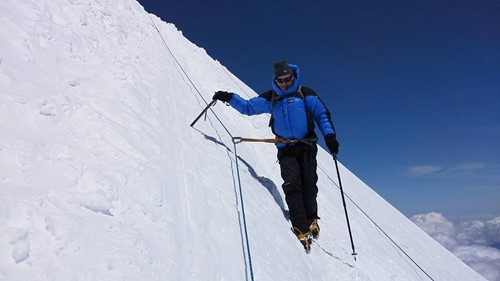
Mt Elbrus is an amazing climb where you must persevere through acclimatization.
How it Feels
You will not 'feel' the air as lighter or notice the different pressure directly. However, the effects on your body and functioning will be obvious to virtually all individuals. Initially, you will get and stay puffed more easily and your appetite may also reduce or disappear.
A lot of people will also experience mild Acute Mountain Sickness (AMS). AMS is often described as feeling like a hangover. For those lucky enough to be unfamiliar with this feeling it can be characterised by:-
Loss of appetite / nausea / vomiting
Fatigue and lethargy
A headache or light-headedness
Difficulty sleeping
Some people will hide or deny the symptoms as they are worried that they will be prevented from continuing on the trek or climb. This is not the case. It is very important that you tell your leader if you start to feel ill so that they can look after you and monitor the group as a whole. Adventure Alternative itineraries are planned with the flexibility to allow you continue even if we have to take a rest day early or alter a route
How our Staff is Trained to Deal with Altitude
Adventure Alternative local staff have experience in working with western clients at altitude and they have climbed the mountain hundreds of times, and they can certainly deal with getting somebody off the mountain. However, it is fair to say that, despite our best efforts, they don't understand the physiological changes going in the human body during ascent, and there is a cultural 'gap' when it comes to them telling to a client to go down. Therefore we do ask that people find out as much as possible in advance about altitude, listen to their bodies during the climb and to some extent self-diagnose with the use of an AMS card (which we provide prior to departure). Making the decision to descend is mostly a very obvious one to make because the symptoms are quite obvious, but it needs to be a collaborative effort between the team and the staff to keep everyone healthy and happy and to deal with a descent if it is necessary.
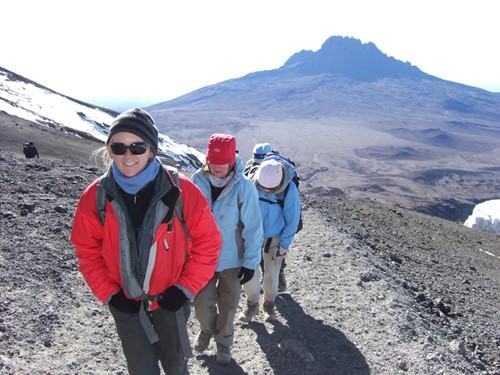
Hikers take care on their summit bid of Kilimanjaro.
MORE SERIOUS DEVELOPMENTS
The effects of mild AMS can be controlled by recognising them, acknowledging them and taking fairly simple and straightforward steps. If these are steps are not taken or are ineffective an individual may progress to more serious AMS and further conditions of High Altitude Pulmonary Oedema (HAPE) and High Altitude Cerebral Oedema (HACE). These conditions can be immediately life-threatening.
What is HACE?
High Altitude Cerebral Oedema is effectively a progression of the same physiological effects as mild AMS. It is essentially due to the swelling of the brain within the skull. The resultant pressure progressively reduces the brain's ability to function. The fact that HACE is a later worsening of mild AMS highlights the importance of acknowledging and addressing the symptoms of mild AMS.
The signs to look for are:-
Confusion
Changes in behaviour
Lethargy
Ataxia (loss of coordination)
Treatment for HACE consists of:-
IMMEDIATE DESCENT, facilitated by:-
Oxygen (if available)
Re-compression Gamow Bag (if available)
Possible administration of Dexamethasone
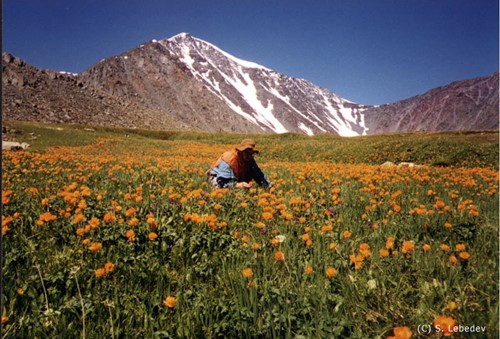
The Altai mountains in Russia offer amazing opportunities for mountain trekking.
What is HAPE?
In simple terms, High Altitude Pulmonary Oedema consists of fluid leaking from blood vessels into the lungs due to constriction and consequent high pressure. The fluid thus builds up and further blocks the passage of oxygen from the lungs into the blood. In this sense, it is similar in effect to drowning.
HAPE in its early stages can be hard to distinguish from other breathing difficulties associated with travel and exertion high altitude.
The specific signs to look for are:-
Decreased exercise performance and rapid breathing
Inability to catch breath even upon rest
Blue lips and nail beds
Crackling sound during breathing
Coughing up pink or red fluid
Treatment for HAPE consists of:-
IMMEDIATE DESCENT, facilitated by:-
Oxygen (if available)
Re-compression Gamow Bag (if available)
Possible administration of Nifedipine
Climbing the ridge towards the top of Yala Peak in the Himalaya.
OTHER EFFECTS
A dry Cough - This is usually due to the dry air or dust - A buff or face mask can help
Heart - Your heart will be working harder due to the reduced oxygen and thickening of the blood - If you have a history of heart problems you should consult your doctor before booking.
Stomach & Bowels - Many people will experience some degree of change to their toiletry habits. This is usually due to the change of diet, poor hygiene or traveller's diarrhoea. If you have any history of stomach or bowel problems you should consult your doctor before booking - Observing good hygiene and keeping well hydrated are essential.
Kidney & Bladder - The physiological effects of altitude include increased urination, the dry air leads to more evaporation and exertion increased sweating. All these mean that you are at increased risk of dehydration - You need to make a concerted effort to stay hydrated by consuming at least 3 litres of fluids a day.
Eyes - There have been reports of problems related to travelling to high altitude soon after undergoing laser eye surgery. If you have any concerns you should consult your optician.
Ears/nose - changes in the inner ear can trigger dizziness and light-headedness common to AMS. A blocked nose is also common and upsets the normal warming process and humidifying process that is essential to keep lungs healthy. This causes a persistent cough. Blow nose regularly, use a wide-brimmed hat, use sunblock and barrier cream.
Sleep - a disturbed sleep pattern is common during the first nights at altitude and is common; lack of sleep over several days indicates poor acclimatisation. ‘Periodic’ breathing during sleep is also common and not dangerous. Snoring may be made worse by dry, dusty air but does not appear to get worse at altitude. Expect to need more sleep, avoid caffeine and alcohol late in the day, and if your sleep does not improve after several days at altitude then consider going down.
More Information About Altitude and Acclimatisation
Travel At High Altitude - Medex - ISBN 0-901100-76-5 [pocket sized leaflet]
(free download http://medex.org.uk/v26%20booklet.pdf)
Altitude Illness - Bezrucha - ISBN 0-89886-685-5 [pocket sized book]
Medicine for Mountaineering - Wilkerson - ISBN 978-1594850769 [large handbook]
UIAA advice sheets - http://www.theuiaa.org/medical_advice.html
Wilderness Medical Society Consensus Guidelines
for the Prevention and Treatment of Acute Altitude Illness
WILDERNESS & ENVIRONMENTAL MEDICINE, 21, 146–155 (2010)
Luks et al
High Altitude Treatment
The following article appeared in the Journal of Travel Medicine under the title;
Do British Commercial Mountaineering Expeditions Carry Drugs to Treat High Altitude Illnesses? (Volume 19, Issue 4, pages 250–252, July 2012)
This appears to be an issue that is clouded by certain companies' fear of legal action in the event of use of the medications. On moral grounds, Adventure Alternative do carry the medications Acetazolamide(Diamox), Nifedipine(Adalat) and Dexamethasone in order to provide the option of them being administered in an extreme emergency situation. In fact, the quote at the top right of page three is from Gavin Bate, MD of Adventure Alternative.


